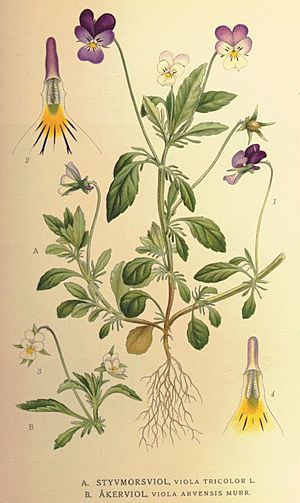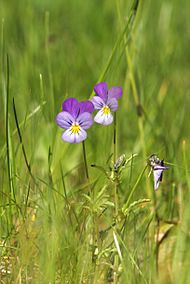Viola tricolor facts for kids
Quick facts for kids Heartsease |
|
|---|---|
 |
|
| Scientific classification | |
| Genus: |
Viola (plant)
|
| Species: |
tricolor
|
Wild pansy (Viola tricolor), also known as Johnny Jump up (though this name is also applied to similar species such as the yellow pansy), heartsease, heart's ease, heart's delight, tickle-my-fancy, Jack-jump-up-and-kiss-me, come-and-cuddle-me, three faces in a hood, love-in-idleness, or pink of my john, is a common European wild flower, growing as an annual or short-lived perennial.
It has been introduced into North America, where it has spread. It is the progenitor of the cultivated pansy, and is therefore sometimes called wild pansy; before the cultivated pansies were developed, "pansy" was an alternative name for the wild form. It can produce up to 50 seeds at a time. The flowers can be purple, blue, yellow or white.
Contents
Description
Viola tricolor is a small plant of creeping and ramping habit, reaching at most 15 cm (6 ins) in height, with flowers about 1.5 centimetres (0.59 in) in diameter. It grows in short grassland on farms and wasteland, chiefly on acid or neutral soils. It is usually found in partial shade. Its root is of the rhizome type with fine rootlets. The stem (acoli stem: which remains flush with the soil and from which leave the leaves and the flowering stalk) is hairless, sometimes downy and is branched. The plant has no leaf rosette at the base, unlike some other violets, such as Viola hirta. Leaves are, on the contrary, alternate. They are stalked at limbus oval, oblong or lanceolate and more or less serrated margins. The stipules are often quite developed, at least those of the upper leaves. These stipules are palm-lined or palmatised.
The flowers are solitary and lateral, hoisted on long peduncles. They appear on aerial stems with more or less long internodes. The sepals are never larger than the corolla. It is 10 to 25 mm long. This corolla can be purple, blue, yellow or white. It can most often be two-tone, yellow and purple. The tricolor shape, yellow, white and purple, is the most sought after.
It flowers from April to September (in the Northern Hemisphere). The plants are hermaphrodite and self-fertile, pollinated by bees.
Habitat
It is common almost everywhere on the Eurasian continent, near the sea or inland, at altitudes ranging from 0 to 2,700 m. It grows in open grasslands, wastelands, mainly on acidic or neutral soils. It is also found on the banks and in the alluviums.
Traditional uses
As some of its names imply, V. tricolor has a long history of use in herbalism and folk medicine, both for epilepsy, skin diseases and eczema, and for respiratory problems such as bronchitis, asthma, and cold symptoms.
It is also a diuretic, leading to its traditional use for rheumatism and cystitis.
The flowers have also been used to make yellow, green and blue-green dyes, while the leaves can be used to indicate acidity.
Mythology
According to Roman mythology, the wild pansy turned into the Love-in-idleness as Cupid shot one of his arrows at the imperial votaress, but missed and instead struck it. As Cupid is the god of desire and affection, the flower’s juice received the trait, to act as a love potion. Its name relates to the use of the flower, as it is often used for idleness or vileness acts.
According to Greek mythology, Zeus fell in love with a young woman named Io and provoked jealousy to his wife Hera. He transformed the girl into a heifer and kept her grazing at his feet. For pity on the diet of herbs to which he submitted the beloved, he caused the earth to produce beautiful flowers that he called Io. Another Greek legend has it that the delicate white flowers were worshiped by Eros. To inhibit this worship, Aphrodite colored them, which resulted in tricolor coloration.
The ancient Greeks and Chinese used the vials as medicine, and the Celts and Romans made perfumes of them.
See also
 In Spanish: Viola tricolor para niños
In Spanish: Viola tricolor para niños


